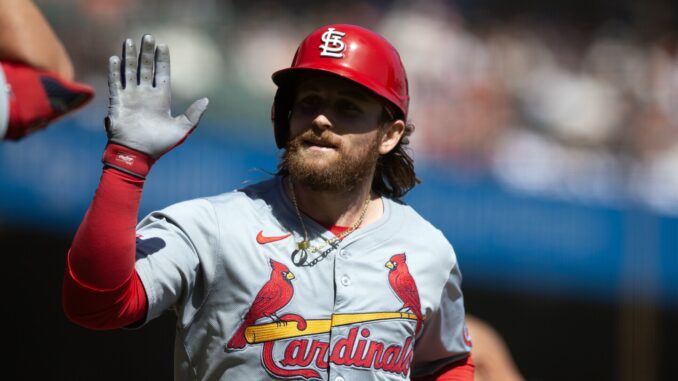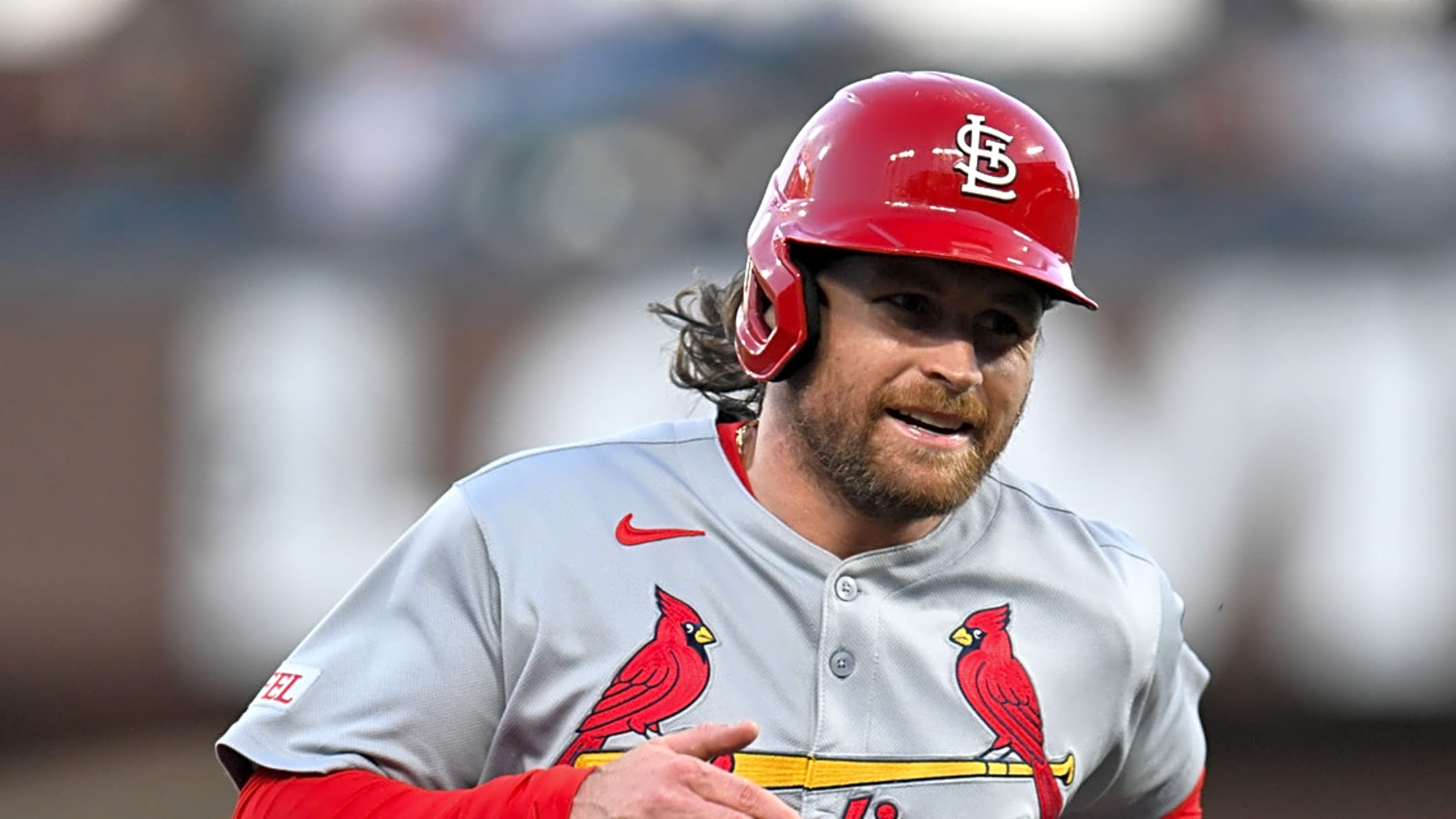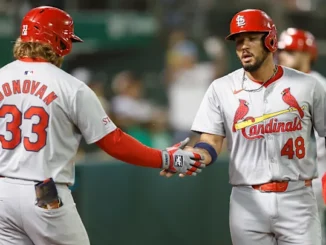
The St. Louis Cardinals appear to be positioning themselves for one of the most significant decisions of their upcoming offseason: moving one of their most valuable and versatile players in order to reshape the roster.
Reports indicate that All-Star infielder and outfielder has caught the attention of a large number of rival organizations, with league-wide interest in his availability described as “massive.” For many fans, the idea of losing a reliable and popular player like Him is difficult to accept. Still, as painful as it may be emotionally, his trade value presents the Cardinals with a rare opportunity to directly address their most pressing weakness: starting pitching.
For a franchise that has prided itself for years on sustainable success and regular postseason contention, the last few seasons have illustrated a clear need for structural improvement. The pitching staff, in particular, has lacked depth, consistency, and impact arms.
More: Phillies Blockbuster Trade Lands Angels’ Slugging Outfielder In 2-Player Deal
If the Cardinals hope to return to their former status as a perennial contender, they must find a way to acquire front-end or near-front-end pitching talent. Brendan Donovan represents one of the best trade chips they’ve had in quite some time, and dealing him at the height of his value could potentially jumpstart a long-overdue course correction.

Naturally, the biggest question among fans and analysts alike is: What is Donovan actually worth on the trade market? To understand that, it helps to look for historical comparisons. One such comparison is Ben Zobrist, a player former Rays front office member Chaim Bloom would know very well. During his career, Zobrist became famous for his defensive versatility and exceptional on-base skills.
He played multiple positions at a high level, provided steady offensive production, and made himself invaluable to every team he played for. That same “Swiss Army Knife” label applies just as well—if not better—to Brendan Donovan.
Donovan’s ability to move around the diamond, whether at second base, third base, or in the outfield, makes him one of the most flexible and useful position players in the league. He consistently gets on base, keeps his strikeout rate low, and produces professional, competitive at-bats. Those traits don’t come cheaply on the open market, especially not in a trade scenario where the trading team can offer multiple years of team control.

To get a clearer sense of Donovan’s worth, comparing him statistically to Zobrist at a similar stage in their respective careers is a logical starting point. Donovan will be entering his age-29 season in 2026, so evaluating both players through their age-28 seasons provides a fair and insightful lens.
Through age 28, Ben Zobrist had appeared in 297 games and recorded 1,129 plate appearances. During that stretch, he hit 42 home runs, drove in 148 runs, walked at an 11.4% rate, and struck out in 16.7% of his plate appearances. His slash line sat at .260/.346/.459, which translated to a .349 weighted on-base average (wOBA), a 113 weighted runs created plus (wRC+), and 8.3 wins above replacement (fWAR).
More: Braves blow to newfound roster flexibility with blockbuster deal for Padres designated hitter
Brendan Donovan’s numbers over that same age span are even more impressive in several areas. He appeared in 492 games and totaled 2,006 plate appearances, giving him a much larger and more consistent sample of performance. He hit 40 home runs and drove in 202 runs. While his walk rate (9%) is slightly lower than Zobrist’s, he more than makes up for it with excellent contact skills, as demonstrated by his low 13.5% strikeout rate. His slash line sits at an outstanding .282/.361/.411, which results in a .340 wOBA, a 119 wRC+, and a 10.1 fWAR.

In other words, Donovan has produced more overall value, generated more consistent offensive output, and provided more defensive versatility than Zobrist did at the same point in their careers. That comparison is essential when evaluating potential trade returns, especially when taking historical trades into account.
One of the most relevant deals involving Zobrist occurred on July 28, 2015. At that time, the Oakland Athletics sent Zobrist to the Kansas City Royals in exchange for pitching prospect Sean Manaea—who was ranked as the 56th overall prospect in baseball by MLB Pipeline—and right-hander Aaron Brooks. That trade gave Kansas City a valuable rental player for a postseason push, and it paid off handsomely as the Royals went on to win the World Series that season.
More: Mariners to make blockbuster trade for $116.5 million Diamondbacks Slugger to replace Leo Rivas
It is important to note, however, that Zobrist in 2015 was a rental player. His contract was set to expire at the end of the season, meaning the Royals were only acquiring a few months of his services. Brendan Donovan’s situation is significantly more valuable by comparison. If the Cardinals were to trade him this offseason, the acquiring team would gain not one, but two full seasons of control over a multi-positional All-Star-caliber player. That extra time dramatically increases his trade value.

Because of that added control, as well as his continued improvement and consistent production, the Cardinals should reasonably expect a return that exceeds what Oakland received for Zobrist in 2015. Instead of a single elite pitching prospect and a complementary piece, St. Louis could aim for an impact-level arm who is either major-league ready or very close to being ready, possibly alongside an additional prospect to sweeten the return.
Attempting to pinpoint specific names or pieces at this stage is largely speculative. With such widespread interest around the league, it’s nearly impossible to predict exactly which organization will step up with the most appealing offer. However, that level of demand actually works in the Cardinals’ favor. A crowded marketplace often leads to a bidding war, and a bidding war is the optimal environment for maximizing return.
Several notable franchises have already been linked to Donovan in various reports, including the Houston Astros, Los Angeles Dodgers, New York Yankees, and Cleveland Guardians. Any one of these teams could benefit greatly from adding a player with Donovan’s skill set, especially a club seeking versatility, consistent on-base ability, and reliable defense heading into less predictable future seasons.

In 2025 alone, Donovan put together a campaign worth 2.9 fWAR, reaffirming that he isn’t just a complementary piece but an impact starter. He improves almost every lineup he enters. With that in mind, it becomes interesting to look around the league at teams where he would represent a clear upgrade at second base, third base, or left field—and where that team might realistically be pushing to contend in 2026.
More: Giants have been priced out of closer market after lucrative deal
Several franchises fit that description. The Athletics (in their Sacramento or Las Vegas transition phase) could use a steady presence in the lineup. The Detroit Tigers might see him as the perfect fit for a young roster on the rise. The Seattle Mariners, particularly if they lose Eugenio Suárez in free agency, could plug Donovan right into a prominent infield spot. Meanwhile, the Texas Rangers, who have cycled through inconsistency and injury issues in recent seasons, might see him as the glue piece that stabilizes both offense and defense.
For any of those organizations, Donovan offers more than just a stat line. He brings a professional approach at the plate, positional flexibility that gives a manager more options, and the kind of steady demeanor that contending teams crave. Those intangible qualities only add to the already significant measurable value.

At this stage, one thing appears increasingly inevitable: Brendan Donovan is unlikely to be wearing a Cardinals uniform in 2026. That reality is disappointing, especially for fans who’ve watched him develop into a cornerstone of the lineup. He embodies the “Cardinal Way” in a lot of respects—gritty, disciplined, dependable, and versatile.
Still, there may be a silver lining in this situation. With Chaim Bloom now in position to steer the franchise’s long-term vision, the Cardinals find themselves in a rare spot of leverage. Few teams can offer a player of Donovan’s caliber with multiple years of control remaining. That reality gives St. Louis significant negotiating power, and if they play their cards right, they could emerge from this trade with the kind of pitching help that changes the trajectory of the organization.
In the end, while it may hurt to say goodbye to one of the team’s most respected and productive players, the return could be transformative. If the Cardinals can turn Brendan Donovan into the arms and talent needed to rebuild a dominant pitching staff, this move may one day be viewed not as a painful loss, but as a necessary and intelligent step in restoring the franchise to sustained excellence.
Brendan Donovan might be the Cardinals’ most sought-after asset at the moment—but how the organization capitalizes on that fact could define the next era of Cardinals baseball.
MORE MLB NEWS:
-
Red Sox officially cut ties with All Star veteran catcher
-
Mariners get significant $24 million Jorge Polanco’s update
-
Blue Jays blockbuster land Diamondbacks’ top second baseman
-
Angels Strike Again, Officially Cut Ties With Top Superstars
-
Mariners basically create super team with $325 million Rangers shortstop “upgrade from J.P. Crawford”
-
BREAKING: Braves strike again, officially cut ties with 2 top players



Be the first to comment